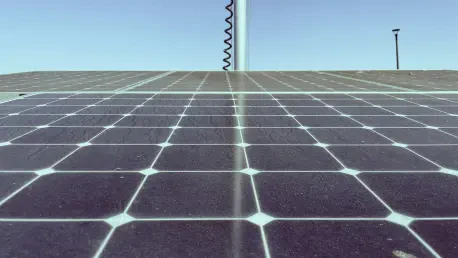In recent years, tandem solar cells have emerged as transformative innovations in green technology, addressing enduring limitations of traditional solar cells. They represent a critical step forward as energy demands rise and climate change concerns escalate. This new wave of solar technology combines well-established silicon photovoltaic systems with perovskite materials, which promise to exceed fundamental efficiency limits that have historically constrained solar energy conversion. The appeal of perovskite lies in its cost-effectiveness and potential for high efficiency. However, these advantages come with challenges, particularly in terms of the material’s chemical stability and scalability for commercial use.
Overcoming Perovskite’s Challenges in Tandem Solar Cells
Stability Achievements by Qcells
Qcells has made remarkable progress in addressing perovskite’s stability issues, a significant hurdle in the development of tandem solar cells. The company successfully completed rigorous stress tests for its tandem modules, aligning with both International Electrotechnical Commission and Underwriters Laboratories standards. These tests not only provide evidence of the stability of Qcells’ technology but also mark a step toward potential mass production and commercialization. The development aligns with industry needs for reliable and efficient solar solutions as consumers and businesses increasingly look to sustainable energy sources.
Passing these stringent tests effectively demonstrates that Qcells’ tandem solar modules are meeting necessary industry benchmarks, positioning them as leaders in the mainstream market. The implications of this achievement are vast, potentially reshaping the landscape of renewable energy by making perovskite-integrated solar technologies more viable. As only the highest-performing technologies pass such rigorous evaluations, Qcells’ progress suggests a burgeoning future of innovative solar solutions that can compete with conventional energy forms in terms of reliability and efficiency.
Technological Advancements by Trinasolar
Trinasolar’s journey into enhancing tandem solar cell technology underscores the importance of strategic partnerships and intellectual property in this field. In collaboration with Oxford PV, Trinasolar has developed a perovskite-silicon module that surpasses 800W output, a significant milestone reflecting its commitment to boosting solar efficiency. This advancement highlights how fostering synergy between companies can expedite innovation and push the boundaries of solar technology advancements.
The exclusive patent licenses acquired by Trinasolar from Oxford PV emphasize the crucial role intellectual property plays in advancing cutting-edge solar technology. These licenses not only secure Trinasolar’s position within the competitive market but also encourage further research and development initiatives. Consequently, this partnership demonstrates a model for collaborative progress in clean energy, suggesting a trend where shared knowledge and resources can accelerate the commercialization of efficient, high-output tandem solar technologies.
Industry Momentum and Strategic Developments
LONGi’s Record Efficiency
LONGi’s accomplishments in maintaining a record-breaking efficiency level for tandem solar cells underscore the increasing momentum within the industry. With an impressive efficiency of 34.85% for its crystalline silicon-perovskite solar cell, as certified by the U.S. National Renewable Energy Laboratory, LONGi sets a formidable benchmark for competitors. This record-breaking achievement highlights the potential for tandem solar technologies to deliver unprecedented energy conversion rates, advancing the goal of making solar power a primary energy source.
Such efficiency not only points to technical mastery but also heralds potential economic benefits for solar consumers by reducing costs per watt of energy generated. These developments signal a shift in the solar industry, where increased efficiency can lead to larger-scale adoption and integration into diverse energy systems. As global energy policies increasingly prioritize sustainability, advancements like LONGi’s will be pivotal in meeting future energy demands.
Collaborative Endeavors Propel Industry Growth
Tandem solar technology’s progress and the sustained interest of major companies mark a collective effort to redefine energy efficiency parameters. The collaborations witnessed within the industry, be it through licensing or joint ventures, exemplify a concerted drive toward mainstreaming tandem solutions. These partnerships contribute to a cycle of innovation where continuous improvements and shared expertise forge new paths for renewable energy.
The industry trend suggests a future where such alliances are foundational to driving the next wave of solar advancements. This landscape of cooperation reflects a broader commitment to achieving sustainability goals, as companies recognize the urgency of transitioning to renewable energy sources. Tandem solar cells, backed by strategic collaborations, are poised to capture significant market interest, contributing not only to energy efficiency but also to environmental responsibility.
Pioneering the Future of Solar Energy
In recent years, tandem solar cells have surfaced as groundbreaking developments in green technology, addressing long-standing shortcomings of conventional solar cells. As energy demands surge and concerns about climate change intensify, they embody a pivotal advancement. This cutting-edge solar technology integrates classic silicon photovoltaic systems with perovskite materials, potentially overcoming the efficiency barriers that have historically impeded solar energy conversion. Perovskite is particularly appealing due to its cost-effectiveness and potential for superior efficiency compared to traditional materials. Nevertheless, these benefits come with specific hurdles, especially regarding the chemical stability of the material and the scalability required for widespread commercial adoption. Researchers and developers are committed to overcoming these obstacles, as achieving this could significantly enhance solar energy solutions, making them more accessible and effective in addressing global energy concerns and sustainability objectives.









